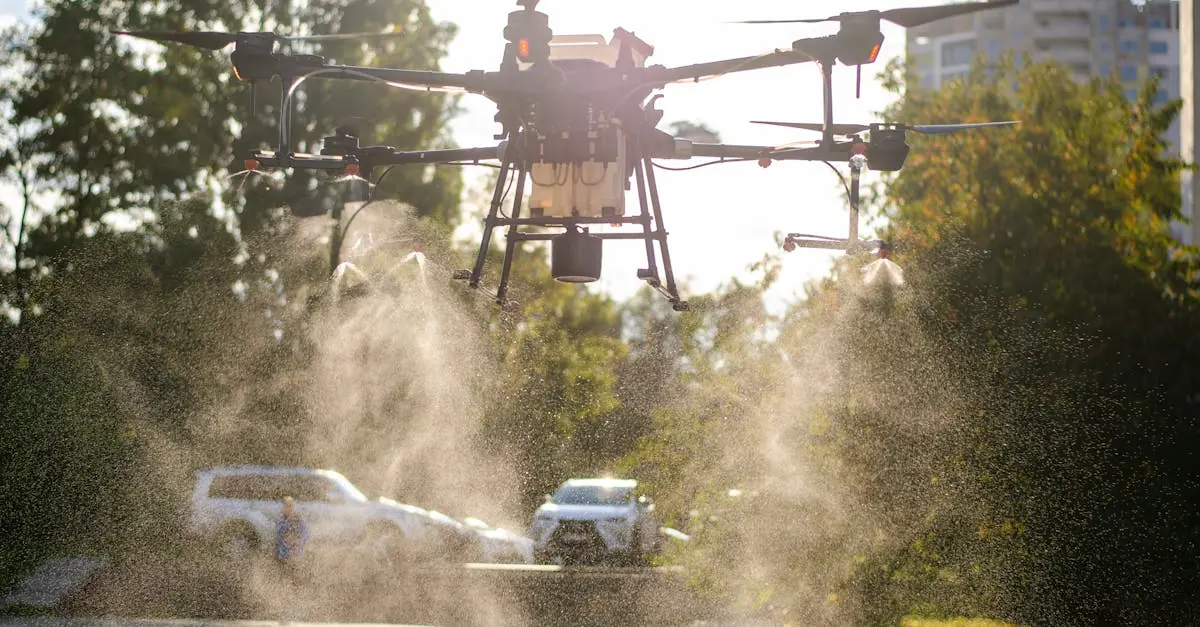In a world where robots are no longer just the stuff of sci-fi movies, robotics and automation engineering is paving the way for a future that’s both exciting and a tad bit terrifying. Imagine a life where machines do the heavy lifting while you sip coffee and contemplate the mysteries of the universe—or at least your next Netflix binge. This field isn’t just about creating metal minions; it’s about revolutionizing industries, enhancing productivity, and maybe even giving the office coffee machine a run for its money.
Table of Contents
ToggleOverview of Robotics and Automation Engineering
Robotics and automation engineering encompasses the design, construction, operation, and use of robots and automated systems. This field integrates various disciplines, including mechanical engineering, electrical engineering, and computer science. Professionals in this domain focus on improving efficiency and precision across numerous industries, such as manufacturing, healthcare, and logistics.
The impact of this engineering discipline is profound. For example, manufacturing robots optimize assembly lines, significantly reducing production time. Healthcare automation enhances patient care through robotic assistance in surgeries and rehabilitation processes. Logistics also benefits from automated systems that streamline inventory management and delivery tasks.
Technology plays a crucial role in robotics and automation engineering. Advanced algorithms enable robots to learn and adapt to different environments, enhancing their functionality. Sensor technology allows robots to interact safely with humans and navigate complex surroundings. Machine learning and artificial intelligence contribute significantly to decision-making processes within automated systems.
Challenges persist within this dynamic field. Ethical considerations arise concerning job displacement due to automation. Ensuring safety and reliability in robot-human interaction remains essential. Furthermore, the integration of diverse technologies often demands extensive testing and validation to achieve optimal performance.
Despite these challenges, robotics and automation engineering continues to evolve rapidly. The integration of smart technologies promises increased flexibility and innovation. As a result, industries are likely to witness enhanced productivity, reduced operational costs, and improved quality of products and services.
Key Disciplines in Robotics
Robotics encompasses various key disciplines, each contributing significantly to the development of automated systems. Understanding these areas is essential to grasping the field’s complexity.
Mechanical Engineering
Mechanical engineering plays a vital role in robotics. This discipline focuses on the design and construction of robotic bodies. Engineers consider factors like structural integrity and material properties. They also develop mechanisms for mobility and articulation. For instance, robotic arms incorporate gears and motors to replicate human movement. Advanced simulation software aids in prototyping and testing designs before production. Innovations in lightweight materials enhance robots’ efficiency, improving performance in various applications.
Electrical Engineering
Electrical engineering is essential for the effective functioning of robots. This discipline addresses the development of circuits and power systems. Engineers design control systems that enable precise movement and functionality. Embedded systems often manage connections between various components, including sensors and actuators. Integrating power supply systems ensures robots operate safely and efficiently. Moreover, advancements in sensor technology allow for enhanced perception, facilitating better environmental interaction. Efficient energy management also extends robots’ operational capabilities, reducing costs in the long run.
Computer Science
Computer science drives the intelligence behind robotic systems. This discipline focuses on algorithms and software development. Programmers create the instructions that govern robot actions, allowing for complex problem-solving capabilities. Machine learning models enable robots to learn from data, improving performance over time. Additionally, computer vision technology empowers robots to process visual information for navigation and task execution. Data analysis contributes to enhanced decision-making by optimizing operational processes. Ultimately, advancements in artificial intelligence continue to transform robot functionalities, making them more adaptable and efficient.
Applications of Robotics and Automation
Robotics and automation find extensive applications across various industries, enhancing efficiency and transforming traditional practices.
Manufacturing Industry
Manufacturing benefits significantly from robotics and automation. Robotic arms perform assembly tasks with precision, reducing production times. Automated guided vehicles streamline material handling, optimizing workflow. Factories increasingly employ smart robots that adapt to changing tasks, boosting flexibility. Implementing these technologies leads to reduced operational costs and enhanced product quality.
Healthcare Sector
Healthcare automation revolutionizes patient care and operational efficiency. Robots assist in surgeries, enhancing precision and minimizing recovery times. Automated systems manage patient data, improving accuracy in medical records. Telepresence robots facilitate remote consultations, expanding access to healthcare. Streamlining medication dispensing with automation reduces errors, ensuring patient safety.
Agricultural Innovations
Agricultural practices undergo transformation through robotics and automation. Drones enable precise crop monitoring, assisting farmers with data-driven decisions. Autonomous tractors enhance planting and harvesting efficiency, reducing labor requirements. Smart irrigation systems optimize water usage, conserving resources while maintaining crop health. The integration of robotics in agriculture leads to increased yields and sustainability.
Future Trends in Robotics and Automation Engineering
The future of robotics and automation engineering is marked by significant advancements. Emerging technologies promise to reshape industries and enhance human capabilities.
Artificial Intelligence Integration
AI integration plays a transformative role in robotics. Intelligent algorithms enable robots to adapt in real-time, enhancing operational efficiency. Machine learning drives data analysis, improving decision-making processes in automation. Natural language processing empowers robots to understand and respond to human commands. Autonomous systems benefit from predictive analytics, optimizing task execution based on historical data. As AI evolves, robots will increasingly handle complex tasks, allowing industries to leverage advanced automation solutions for improved productivity.
Collaborative Robots (Cobots)
Cobots are revolutionizing workplace dynamics by working alongside humans. These robots prioritize safety, equipped with sensors that detect human presence and adjust their actions accordingly. Designed for versatility, cobots assist in various applications from assembly to packaging. Small and lightweight, they can easily integrate into existing workflows without the need for extensive modifications. Enhanced programming allows operators to teach cobots new tasks quickly. The growing adoption of cobots promotes better collaboration and improves overall efficiency in multiple sectors.
Challenges Facing the Field
Robotics and automation engineering faces several significant challenges that impact its progression and application in various sectors.
Ethical Considerations
Ethical considerations present critical concerns in the robotics field. Developers must address the implications of autonomous systems making decisions. Consequently, accountability and transparency become essential when robots operate in sensitive environments. Additionally, data privacy plays a crucial role as robots often collect and analyze vast amounts of personal information. Ensuring that technology adheres to ethical standards is vital for gaining public trust. Regulations may need to evolve to keep pace with rapid advancements, ensuring responsible use of automation technology. All stakeholders must collaborate to establish guidelines conducive to innovation while safeguarding human values.
Workforce Displacement
Workforce displacement poses a significant challenge as robots increasingly replace human labor in various industries. Companies may prioritize cutting costs through automation, leading to job losses for many workers. Consequently, reskilling opportunities become essential for those affected, helping them transition to new roles in the evolving job market. Moreover, society must adapt to changing workforce dynamics, preparing individuals for positions that require more complex and creative problem-solving skills. Industries must emphasize worker retraining and the development of complementary roles that robots cannot readily assume. Overall, integrating automation while protecting the workforce requires thoughtful approaches and proactive measures from employers and policymakers.
Robotics and automation engineering stands at the forefront of technological advancement. As industries continue to embrace these innovations, the potential for enhanced productivity and efficiency grows exponentially. The integration of artificial intelligence and machine learning is paving the way for smarter, more adaptable systems that can revolutionize workflows.
While challenges such as ethical considerations and job displacement remain, the benefits far outweigh the obstacles. The evolution of collaborative robots promises safer and more efficient human-robot interactions, making it easier for businesses to adapt. As this field progresses, it’s clear that robotics and automation will play a crucial role in shaping the future of work and industry, ultimately leading to a more innovative and productive society.



